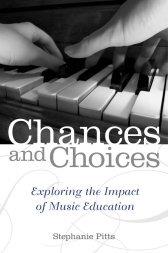 Chances and Choices: Exploring the Impact of Music Education, by Stephanie Pitts. London: Oxford University Press, 2012. ISBN: 978-0199838776
Chances and Choices: Exploring the Impact of Music Education, by Stephanie Pitts. London: Oxford University Press, 2012. ISBN: 978-0199838776
It is often said that “you can’t judge a book by its cover.” In this case, one cannot judge this book by its title, either. Chances and Choices is based on dissertation work by Stephanie Pitts. This nifty book, however, goes far beyond the pedantic to explore the types of choices made by three different groups of people: students who go into music education, members of the general public who make music a lifelong hobby, and adults who have chosen not to be a part of formal music ensembles and experiences.
The first two chapters provide the research models and a discussion about quantitative and qualitative methodologies used in the original study. These chapters also provide a concise overview of international trends in music education during the twentieth century. Music educators who are not especially interested in research models may find these chapters difficult to read, however, and may wish to skip them. But for those who are not experienced researchers and want to use interviews for their own research, Pitts provides a solid explanation for her sociological methodology of multiple case studies, and the contextual framework for the rest of the book.
Beginning with Chapter 3, Pitts examines the locations in which musical learning takes place by explaining that “Musical learning takes place across a range of locations: in school classrooms and in school halls after hours, through singing at church, by attending concert venues, a corner of the dining room at home…and in unexpected conversations with adults in their lives” (p. 82). She then notes that many music educators do not allow for the variety of musical experiences that students bring into the classroom, and believes that teacher direction actually inhibits student learning. In her analysis of locations, she points out that students need to have connections between school music and home music in order to continue to participate in school ensembles.
After Pitts examines the locations of music making, she identifies significant people who inspire, affirm and challenge students during their formative years. She first analyzes the formal experiences that the subjects have had, and then addresses the importance of subjects’ parents: “The life history respondents show an appreciation for people who provided them not only with skills and opportunities but also with a sense of the value of music, whether demonstrated by adults through their own involvement or through their support for the respondent’s own childhood activities” (p. 114).
In the summary of this chapter, Pitts states that she has uncovered a research strand that has not been fully investigated prior to her study. In many research studies, participants are often full time, professional musicians or educators. They have many developmental commonalities in levels of support from parents and peers. Pitts notes that music professionals and educators need to do a better job of making “parents and pupils more aware of the lifelong potential of musical learning” (p. 115).
The final chapter outlines the impact of lifelong learning and involvement in music. Pitts investigated three strands: those who participated in adult activities based on skills they acquired during their childhood and adolescence, those who began to acquire skills on voice or an instrument as an adult, and those who attended concerts, but did not participate in music making. During her interviews, she determined that there were many paths to adult participation in music, but there were also common trends dealing with obstacles for participation: lack of opportunity or inclination, loss of confidence, self-perceived decline in skills, or a sense that chances lost during childhood could not be reclaimed (p. 150).
This book also provides a research summary, identifies significant locations and people who influence musical growth and the resulting lifelong learning. At the end of each chapter, Pitts has included a brief summary of interviews with two participants. These “Interludes” provide summarizing insights based on the contents of the chapter. Additional summaries of the eighty-one interviews used in this book are included on a companion website.
There are two weaknesses in this book. First, because of the nature of this type of research, most of the interviews are older, with the analysis of music education trends ending in 2000. Second, most of the information is gleaned from British participants, though she interviewed some subjects from Italy and the United States while developing this book. Both of these weaknesses may be considered simultaneous strengths, as the issues identified and analyzed by Pitts are common to many time periods and locations.
Pitts has done a commendable job of interviewing a broad range of people who are participating in music as professional or amateur adult music makers. The book is also a good supplement for graduate students or researchers who have never done a hybrid qualitative/quantitative study. Her clear outlines of methodology and her comprehensive analysis of results provide a good model for anyone who wants to engage in this type of research. The book is also a good resource for anyone who engages in music education advocacy. Pitts has provided well-crafted reasons for the inclusion of music education in the home, school and community. Finally, the Interludes and summaries are engaging and enjoyable for anyone who believes that music education should be a lifelong learning activity.
